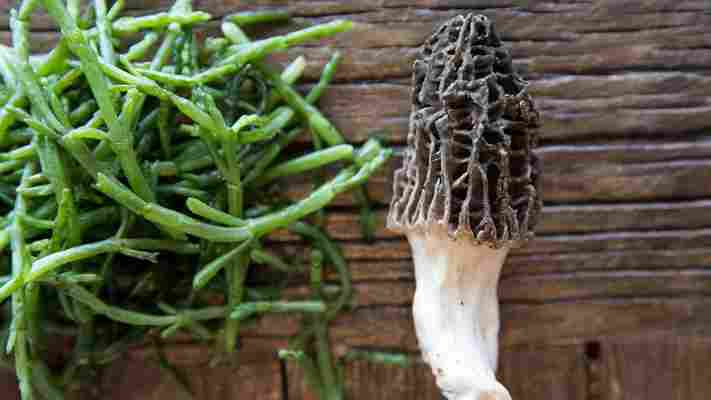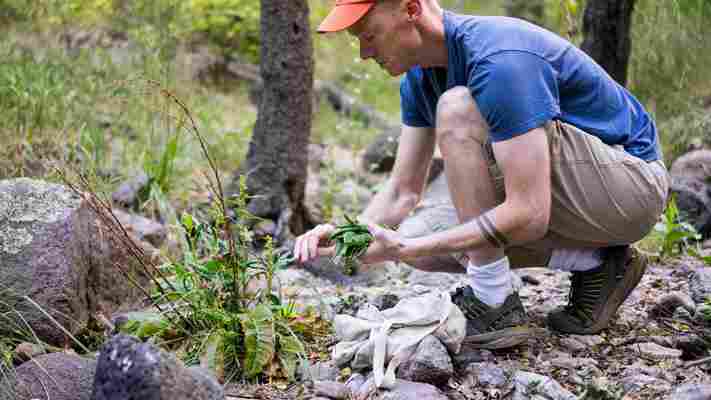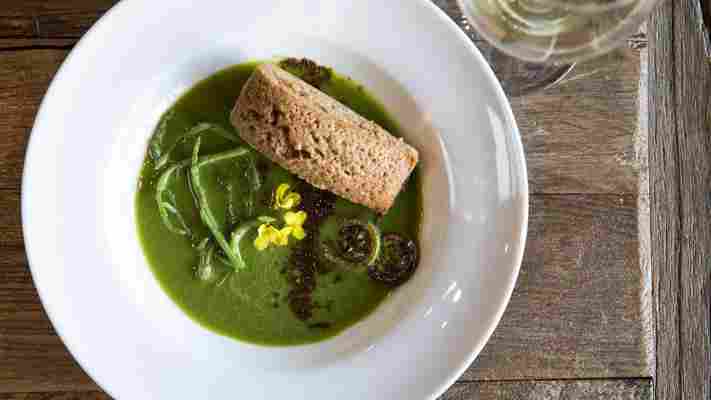It was during the first interlude of my inaugural foray into Ozarkian food, moments before the toasted koji butter-cooked winter squash was set in front of me, and not long after the aroma of persimmon-wood smoked cornbread – fixed atop a rich, blonde pool of sorghum custard – had hijacked my olfactory nerve, when Rob Connoley shifted my attention, halting the sensory delight.

You have to scratch a little harder to find Ozark cuisine
“We probably have two more interns than any other restaurant in the country,” said the chef-owner at Bulrush , a St Louis, Missouri, restaurant putting a modern spin on the traditional foods and flavours of the Ozark Plateau, a mountainous region in the US that includes the states of Missouri, Arkansas and parts of Oklahoma and Kansas. Interns... at a restaurant? I thought. Then, just as my fork reached for the maple syrup mousse on the now-served second course of the night’s seven-course seasonal menu – again, I was halted.

Chef Rob Connoley is best known for his amalgamation of modernist cooking and foraged ingredients (Credit: Jay Hemphill)
“Written records show this squash – called ‘cushaw’ – being used in the Ozarks during the 19th Century,” Connoley added casually, as if centuries-old culinary data mined from the diaries, family letters and agricultural archives of yore were a common side dish like spinach or potato salad. Part history lesson, part super-regional Chef’s Table episode, the dinner – and subsequent plate-by-plate bibliography – continued through dessert (black walnut dacquoise speckled with the essence of decaying leaves), captivating my mind in a way no meal ever had.
While the evening was spectacular, I wasn’t sure if I’d left with a better grasp of Ozark cuisine, a remarkably diverse food culture influenced by the Osage, Chippewa and Cherokee Native American tribes; white Appalachian settlers; enslaved Africans; and German, Scottish and Swedish immigrants who have all called the rolling region home. What did resonate, however, was the shared memory of a fellow diner sitting next to me, who, following a particular dish, recalled the black-eyed peas of her youth as cooked by her late grandmother, a lifelong Arkansan. I wondered: was her evocation the payoff Connoley might be hoping for?
Founded in 2019, Bulrush is the heavily researched brainchild of Connoley, a self-taught, James Beard -nominated chef best known for his amalgamation of modernist cooking and foraged ingredients that turned the don’t-blink-twice town of Silver City, New Mexico – spurred by his first restaurant, the Curious Kumquat – into last decade’s most unlikely US food destination. In 2016, after 20 years away from his native St Louis, he closed the award-winning restaurant and returned home.

(Credit: Bulrush)
(Credit: Bulrush)
(Credit: Bulrush)
(Credit: Bulrush)
(Credit: Bulrush)
(Credit: Bulrush)
(Credit: Bulrush)
(Credit: Bulrush)
(Credit: Bulrush)
(Credit: Bulrush)
Over the past few years, inspired by childhood summers spent at his family’s cabin in southern Missouri, Connoley has gone all-in in an attempt to give voice to Ozark cuisine, called “High South Cuisine” by some, a marginalised genre of food he admits “time has not treated well”. So foggy is its definition that, during the onset of his quest, virtually no Ozarker could give him a uniformed answer – that was, if a local had a response altogether.
“You have to scratch a little harder to find Ozark cuisine,” he said, conceding that a textbook description probably doesn’t exist. “But it’s there – buried in family traditions and written lore.”
You may also be interested in: • A forgotten food of the American South • The US South’s iconic pig ear sandwich • New Orleans’ secret hangover cure
And so, Connoley’s adventure began. Since moving home, he has studied academic journals, spoken with historians, conservationists and paleoethnobotanists, and combed through rare book collections at university libraries from Springfield, Missouri, to Little Rock and Fayetteville, Arkansas.
Working backwards in time, Connoley first encountered the back-to-the-land movement of the 1960s and ‘70s when hippies and anti-Vietnam War protestors shunned society and retreated deep into the sheltered Ozark hills.
Park & Dine
Bulrush remains open during Covid
In addition to curbside carryout and delivery, Bulrush offers diners the option to order from its tasting menu from their cars. Some people set up picnics or just pop their trunk and eat from there.
Bulrush puts a modern spin on the traditional foods and flavours of the Ozark Plateau (Credit: Bulrush)
Problem was, there were no recipes (called “receipts” back then) until 1843 or so when commercial baking powder hit the market. Even then, by the mid-19th Century, it was fruitcake and that was about it. While Connoley wasn’t seeking to duplicate deep-rooted Ozark recipes, they could have helped him form an ingredient list. That’s when he dug deeper and started reading early 19th-Century diaries and family letters (the oldest being from 1820) to learn what Ozarks people grew, ate, hunted and foraged. Hence the interns from nearby St Louis University.
“The most challenging aspect of the research was definitely trying to read the 19th-Century handwriting,” said Gabriel Shoemaker, a senior intern at Bulrush for the 2019-2020 academic year. “It got easier but was never a walk in the park.”
For Bulrush, Shoemaker spent countless hours transcribing letters, his most noted discovery being a cattle reference penned by a M Pope of Arkansas to a certain Martha on 20 December 1869. The first-hand evidence of cows in the area gave Bulrush the documentation it needed to justify adding beef to its menu, which, eight months post-opening, they’d yet to serve due to the lack of literature supporting such an inclusion. (For Connoley, what’s not on the menu can be just as important as what is.)
Another valued find for Shoemaker happened on a research trip to Harvard’s Arnold Arboretum while working on his university capstone project on the political history of the Ozarks. There, he unearthed an encyclopaedia of Native American ethnobotany describing the flora used by various tribes that lived in the Ozarks. (Though he’s built a relationship with the Osage Nation, out of respect for Native American culture, Connoley hasn’t implemented that storytelling into the Bulrush experience. “It’s not my story to tell,” he said).
Earlier this year, one of the more unexpected breakthroughs happened when Connoley visited the recorder of deeds in downtown St Louis, where he uncovered a seed list from 1841. Nearly 100 seeds and their varietals were recorded on the inventory, proof of crops grown in the area at the time. With both biodiversity and flavour diversity in mind, Connoley partnered with a dozen local farmers and two seed specialists to regrow some of these historical foods such as Brown Dutch lettuce and Oxheart cabbage. Separately, Natalie Mueller, an ethnobotanist at Washington University, has introduced him to lost native crops such as wild quinoa, also known as lambsquarters, and knotweed, a buckwheat relative.
“It was very moving to see the plants I study served as food again after so many centuries of sleeping,” Mueller said of her Bulrush visit.
As with many underrepresented food cultures, there are a plethora of stereotypes and misconceptions pinned to Ozark cuisine, convoluting its past all the more. The ubiquity of fast-food chains and convenience foods has resulted in these old-style dishes being labelled as “poor-people’s food.”
I believe us to be true ‘back-to-landers’ – before it was a thing
“Squirrel brains or possum don’t often make the menu of Ozark kitchens these days,” said Erin Rowe, chef and author of An Ozark Culinary History: Northwest Arkansas Traditions from Corn Dodgers to Squirrel Meatloaf . “In the current vernacular, we are still very much thought of as ‘backwoods’ and ‘redneck’. Alternatively, I believe us to be true ‘back-to-landers’ – before it was a thing.”
Historically, a pre-1870 Ozarkian diet consisted of both hunted and foraged foods. For wild game, there was venison, squirrel, rabbit, possum, beaver tail, hazel splitters (now called razorback hogs) and bear, the latter used in abundance in Arkansas, once nicknamed the “Bear State”. Rowe’s book tells the story of a Cherokee family who, while caring for a missionary and his men one winter, prepared a stew of beans and pumpkin with about 8lbs of smoked bear meat – “a pure mass of fat and not less than five inches thick”. “Simple fare cooked low and slow over fire,” Rowe said. Connoley too has seen bear in his research, even hams made of the large mammal.
Come autumn, 75% of Bulrush's menu features foraged ingredients (Credit: Bulrush)
Black walnuts, persimmons, wild grapes, pokeweed , pecans, acorns and a variety of berries were of-the-day foraging staples. Connoley and his staff have gathered more than 50 different Missouri plants in cooperation with conservationists and landowners, some of which have been analysed by experts for their nutritional value. Come autumn, when pawpaws, acorns and hen-of-the-woods mushrooms are ripe for picking, his menu features 75% foraged ingredients. Last month, I joined the chef for a stiflingly humid chanterelle expedition; five nights later, the fruits of our labour garnished a nurturing bowl of sweet corn soup.
Clue by clue, ingredient by ingredient, Connoley has resurrected the flavours and stories of a forgotten food culture. He knows his contemporary Ozark creations are a far cry from the meals great-grandma once plated, noting the essentiality of cooking for a modern audience. The food, of course, was never meant to be a literal expose, but a sensory experience into the soul of a place.
During one seating last summer, a 90-something man dined at Bulrush with his grandson. When the meal ended, the lifelong Ozarker, who’d been quiet throughout dinner, flagged down Connoley and his sous-chef, Justin Bell. The moment of truth, the chefs assumed, had arrived. “I didn’t recognise a single thing you served me,” the man said, pausing long enough to make their hearts drop to the floor. “But every course reminded me of my childhood.” The anecdote epitomises Connoley’s notion of Bulrush as a project more so than a restaurant.
“I don’t think the universe would be shaken if Ozark cuisine was lost to time,” he said, admitting that his research might be arbitrary to some. “But it certainly deserves a fighting chance at being celebrated.”
Join more than three million BBC Travel fans by liking us on Facebook , or follow us on Twitter and Instagram .
If you liked this story, sign up for the weekly bbc.com features newsletter called "The Essential List". A handpicked selection of stories from BBC Future, Culture, Worklife and Travel, delivered to your inbox every Friday.
